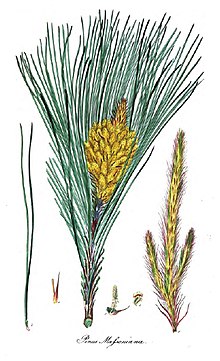Pinus massoniana
| Masson's pine | |
|---|---|

| |
| Scientific classification | |
| Kingdom: | Plantae |
| Clade: | Tracheophytes |
| Clade: | Gymnospermae |
| Division: | Pinophyta |
| Class: | Pinopsida |
| Order: | Pinales |
| Family: | Pinaceae |
| Genus: | Pinus |
| Subgenus: | P. subg. Pinus
|
| Section: | P. sect. Pinus
|
| Subsection: | P. subsect. Pinus
|
| Species: | P. massoniana
|
| Binomial name | |
| Pinus massoniana | |
Pinus massoniana (English: Masson's pine, Chinese red pine, horsetail pine; Chinese: 馬尾松) is a species of pine, native to Taiwan, a wide area of central and southern China, and northern Vietnam.
Description

It is an
leaves are needle-like, dark green, with two per fascicle, 12–20 centimetres (4+1⁄2–8 inches) long and 0.8–1 millimetre (1⁄32–3⁄64 in) wide, the persistent fascicle sheath 1.5–2 cm (5⁄8–3⁄4 in) long. The cones are ovoid, 4–7 cm (1+5⁄8–2+3⁄4 in) long, chestnut-brown, opening when mature in late winter to 4–6 cm (1+5⁄8–2+3⁄8 in) broad. The seeds are winged, 4–6 mm (5⁄32–1⁄4 in) long with a 10–15 mm (3⁄8–9⁄16 in) wing. Pollination occurs in mid-spring, with the cones maturing 18–20 months after.[2][3][4]
Distribution and habitat
It is native to Taiwan, a wide area of central and southern China including Hong Kong, and northern Vietnam, growing at low to moderate altitudes, mostly below 1,500 m (4,900 ft) but rarely up to 2,000 m (6,600 ft) above sea level.[5]
Ecology
In the 1970s and 80s, the
pine-needle scale insect from Taiwan, together virtually eliminated the native Pinus massoniana in Hong Kong.[6]
Fossil record
A
Hainan Island in southern China.[7]
Uses
The species is a common tree used in
slash pine
(P. elliottii).
Logs are mainly used to make pulp for paper industry.
Leaves are used to give special smoke flavor to a local black tea, such as Lapsang souchong of Fujian.
Habit
Notes
- .
- ISBN 90-04-13916-8.
- ISBN 0-521-55176-5.
- ^ Gymnosperm Database: Pinus massoniana
- ^ Mirov, N. T. (1967). The Genus Pinus. Ronald Press.
- ^ Porcupine! 23 - Hong Kong's Bad Biodiversity
- ^ The occurrence of Pinus massoniana Lambert (Pinaceae) from the upper Miocene of Yunnan, SW China and its implications for paleogeography and paleoclimate by Jian-Wei Zhang, Ashalata D'Rozario, Jonathan M. Adams, Xiao-Qing Liang, Frédéric M.B. Jacquesa, Tao Su and Zhe-Kun Zhoua, Review of Palaeobotany and Palynology Volume 215, April 2015, Pages 57-67
- ^ Ecosystem services of various types of artificial forest in South China – a provisional summary
References
- Farjon, A. (2013). "Pinus massoniana". .
- Pinus massoniana - Plants For A Future database report
- eFloras, Missouri Botanical Garden & Harvard University Herbaria, Pinus massoniana, vol. 4, p. 14, retrieved 23 October 2009
Wikispecies has information related to Pinus massoniana.
Wikimedia Commons has media related to Pinus massoniana.




